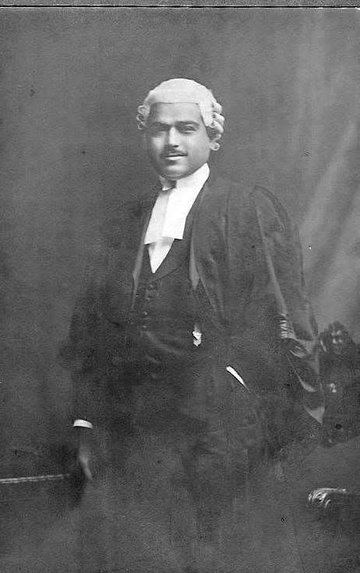
Ram Singh Nehra
‐
Wembley resident and lawyer who was involved in the League of Coloured Peoples and multiple other organizations to support Indians and race relations in mid-twentieth-century Britain
Place of birth
Date of arrival to Britain
Location(s)
121 Preston Road
Wembley
London
United Kingdom
Place of death
London
Date of time spent in Britain
1919–23, 1929–40, 1945–65
About
Ram Singh Nehra was born in Ludhiana, Punjab in 1896. In 1919 Nehra moved to Britain to pursue a law degree at London University and qualified as a barrister at Middle Temple in 1921. Nehra then moved to Mombasa, British Kenya to practise law, where he was appointed a Member of Parliament to represent the Indian population.
Passenger records show that Eileen Myfanwy Brazel, a shorthand typist whom Nehra had met and married shortly before leaving London, boarded a ship to Mombasa in June 1923. Myfanwy returned to Britain to give birth to their first child, Grenville, at her parents' home in Swansea in December 1925. She rejoined Nehra in Kenya in 1926. In 1929 the couple returned to London and moved into a newly built semi-detached house at 121 Preston Road, Wembley, which they named 'Mombasa'. The following year, they welcomed their second child, Sheila. That same year Nehra began practising as a solicitor, becoming the first Indian to do so in London.
The Nehra family later rented out their Wembley home and relocated to 34 Chalkhill Road in south London, which they called 'The Shalimar'. Alongside his legal career, Nehra became involved in community affairs, serving as Joint Honorary Secretary of the British Indian Union – an organization focused on strengthening relations between Britain and India – and as President of the Central Hindu Society of Great Britain.
Nehra served as Treasurer of the League of Coloured Peoples. In a speech by Nehra featured in the July 1933 issue of the League's magazine The Keys, he stressed the need for cooperation between Indians and Africans to achieve meaningful racial progress. Nehra also founded and edited a magazine called The Indian. Published between 1934 and 1937, the magazine covered diverse topics, including Indian self-rule, the caste system and – notably in Nehra’s own writings – racial prejudice. In his 1935 article ‘Colour Hatred’, for example, Nehra drew connections between racism in Britain, Nazi Germany and Fascist Italy while pondering collective resistance.
Nehra was supportive of Indian students coming to Britain. Through The Indian he published exam results of Indian students studying law in Britain and provided practical advice on adapting to life in Britain, including what clothes would be suitable for Indians to bring with them, as well as how to deal with ‘western tasteless foods’. Nehra also personally welcomed new Indian students to London by hosting receptions at Veeraswamy’s.
In 1934 Nehra ran as a Labour Party candidate for a seat on the Wembley Council. He narrowly lost the election by thirty-five votes.
In 1937 Nehra purchased land on the East Sussex coast with plans to develop an estate of seaside bungalows. By 1939 he and his growing family – now with the addition of their third child, Brian, born in 1936 – moved to the estate, settling at 3 Grenville Road, named after their eldest son. That same year, in July, the Nehras welcomed their fourth child, Ruby.
After the outbreak of the Second World War, the Nehra family left England in January 1940 for a family tour of India. Myfanwy passed away in September 1940. During this time, Nehra's legal practice in London collapsed due to embezzlement by his clerk, Bernard Linder. After the war ended, Nehra and his family returned to England. Upon his return, Nehra sold his house on Chalkhill Road to settle his debts. Nehra and his family moved back into their Wembley house on Preston Road, where he would remain for the rest of his life. In 1947 Nehra married Emily Louisa Westgate, the children’s former nanny who had lived with the family in East Sussex and accompanied them to India, standing by their side during their hardships.
In 1949 Emily gave birth to Nehra’s fifth child, Julia. That same year, Nehra resumed his legal career as a solicitor, specializing in criminal cases at the Old Bailey. He also re-engaged with causes he had championed before the war, becoming President of the Punjabi Society of London and playing an active role in the Coloured People’s Aid Society.
Nehra passed away on 29 June 1965 after a brief illness. His funeral was held at Golders Green Crematorium, where a long queue of mourners stretched around the building, far exceeding the chapel’s capacity – a final testament to the deep respect and admiration from the communities he had served.
Grant, Philip, ‘A Wembley Indian from the 1930s’, https://drive.google.com/file/d/1sHpr071_eIeJTG9PNVXvrg7RGXGnDOEn/view
Matera, Marc, Black London: The Imperial Metropolis and Decolonization in the Twentieth Century (Oakland: University of California Press, 2015)
The Nehra Family, The Mixed Museum, https://mixedmuseum.org.uk/btcotc/the-nehra-family/
Image credit
Ram Singh Nehra in Barrister Robes: Photograph reproduced with permission from private collection of Tyrone Naylor (Nehra) - copyright Nehra Family Collection
Entry credit
Tristen Naylor and Tyrone Naylor
